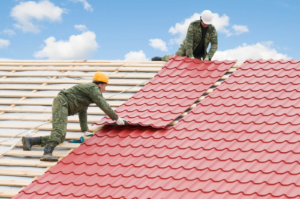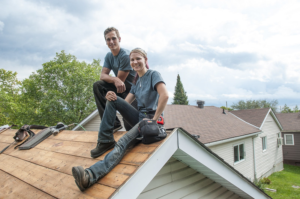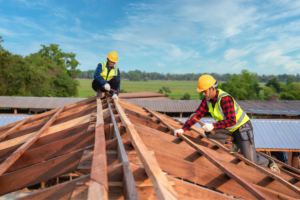Burlington Roofing is the first line of defense against weather elements and a vital part of every building structure. Without roofers, buildings would be susceptible to leaks and loss of energy efficiency.
Before a roofer begins work, it’s important to remove any decorations on walls because the vibrations of hammering could knock them down. Also, be sure to clear the area around chimneys, wood stove pipes, vents and ridge vents.

Clay tile and slate shingles are a beautiful roofing option for homeowners who want to add a traditional style to their home. These shingles have a long lifespan and provide many benefits to homeowners. They are also highly fire-resistant and wick off rainwater more effectively than asphalt shingles. They are also less susceptible to algae growth and rot. These shingles also have a distinct look and can complement any architectural style. However, these shingles are expensive compared to other roofing materials and require a significant investment in labor and installation.
Clay shingles are made by baking molded clay until it is hardened. This process produces a variety of colors, including white, yellow or orange and brown. A common color for clay shingles is terracotta, which has the familiar burnt-orange tint that most people associate with traditional Spanish style homes. These shingles are incredibly durable and can last up to 100 years or more. They are also water resistant and withstand hurricane-strength winds. They can even be used in coastal areas where salty air can damage metal and asphalt shingles.
They are also an excellent energy-efficient choice, as they help regulate indoor temperatures and reduce the strain on HVAC systems. However, clay tiles are more susceptible to cracking and tearing when they are handled improperly. They must be carefully installed and maintained by professional roofers. These shingles are also very heavy and can overload a roof, which requires a more stable structural design.
Unlike other roofing materials, tile roofs are extremely durable and can last up to 50 years. They are a popular roofing option in Europe, where they are often seen on historical buildings and other structures. The durability of these shingles comes at a cost, though, as the initial expense can be prohibitive for some homeowners. The initial expense does not include any upgrades to the structure that may be needed to support the heaviness of these shingles.
Unlike shingle roofs, a tile or slate roof can be easily maintained and cleaned. Regular inspections of the roof should be conducted to identify potential problems and address them quickly. In addition, debris should be cleared from the roof to avoid clogging gutters. It is also a good idea to install wire mesh covers over the gutters to prevent excessive debris buildup.
Asphalt shingles
Asphalt shingles are the roofing material of choice for four out of five American homes. They are inexpensive, versatile and durable. Their variety of shapes, colors, and styles make them a great choice for any home style or architectural design. Regardless of their color or style, they all are manufactured in the same basic way using a few key raw materials. If you’re in the market for a new roof, it helps to understand how these shingles are made so you can have an informed conversation with your roofing contractor.
There are two basic types of shingle: strip and dimensional. Strip shingles have three regularly spaced tabs and a repetitive pattern. Dimensional shingles are more expensive but are also more visually appealing and provide better weatherproofing protection. These shingles are designed with a thicker fiberglass mat base and ceramic-coated mineral granules embedded in carefully refined, water-resistant asphalt.
The shingle base, which is either organic felt or fiberglass, is the primary component in any shingle. The granules are then embedded in the asphalt and held there with resins or binders. The asphalt used in the shingles is different than that used to pave roads, which is why shingle manufacturers refer to them as “composition” shingles rather than asphalt shingles.
To enhance the durability of the shingle, fillers are added to the asphalt during production. These fillers help reinforce the shingle and protect it from moisture damage, while also increasing its fire resistance. Mineral stabilizers are also added to the shingle during manufacturing to reduce the degradation caused by UV light.
Another important material in any shingle is the underlayment, which is installed over the roof deck before a shingle is applied. The underlayment provides a waterproofing layer and a barrier to prevent moisture infiltration that would otherwise damage the roof surface and cause leaks. The underlayment is also treated with fire-resistant chemicals to reduce the risk of shingle fires. Once the shingle is installed, flashing around chimneys and vents is applied. This protects the shingle from moisture infiltration, while also providing an effective seal against wind-driven rain and snow.
Metal shingles
Metal shingles are a durable roofing option that is highly resilient and long-lasting. They are crafted from premium materials and feature a wide variety of styles, colors, and installation options. They can withstand extreme weather elements and corrosion, making them an excellent choice for homeowners who want a roof that protects their homes from severe damage.
They can also help lower energy costs by reflecting sunlight and reducing the amount of radiant heat that the house absorbs. Additionally, they can improve the look of the home and enhance its curb appeal. While they are more expensive than asphalt shingles, their long lifespan and minimal maintenance requirements make them a cost-effective option over time.
Many types of metal roofing are available, including corrugated panels and ribbed panels. These are primarily used for industrial or agricultural applications, but they are increasingly being used on residential properties as well. They are available in a range of finishes and colours, and they can be curved for a more attractive appearance.
The most popular type of metal shingle is the interlocking metal shingle, which features raised seams that lock together and are installed in overlapping rows. It can be made from a variety of materials, including copper and galvanized steel. In the United States, copper shingles are typically made from sheet metal that has been stamped and pressed to resemble the look of traditional shingles or slate.
Another type of metal shingle is the stone-coated metal shingle, which looks similar to traditional shingles and offers a number of design advantages. For example, it requires less maintenance than other types of shingles and is non-combustible. In addition, the stone coating provides UV protection and helps reduce energy costs.
Other metal shingles are designed to mimic the look of natural roofing materials, such as cedar or slate. For example, the Tilcor CF stone-coated metal shingles feature an architectural design and concealed fasteners that keep screws and gaps from exposing the structure to the elements. In addition to the aesthetic benefits, these shingles can reduce cooling bills and may even qualify for insurance discounts.
Shingles made of other materials
Whether you’re building your dream home or replacing an existing roof, the type of shingle you choose will have a significant impact on your roof’s appearance and durability. In addition, your choice of shingle material can affect your home’s energy efficiency and price. To help you make the right decision, here is a look at some of the most popular roofing materials and their components.
Fiberglass shingles begin with a layer of fiberglass mat that’s coated with asphalt to create a waterproof membrane. This coating also helps the shingle hold up against severe weather. Then, granules are applied to the top of the shingle to give it added strength and provide a color contrast. The granules also block damaging UV rays from reaching the asphalt.
The next step is cutting, which is when the large roll of shingle material is cut into individual pieces. These are then stacked and sealed in packages for distribution. Finally, a thin sheet of cellophane is attached to the back of the shingle to prevent it from sticking to other shingles during shipping and storage.
Wood shingles are made from various types of trees and offer a classic, traditional look. They are often a good option for older homes with more traditional roofs. However, they can be susceptible to water damage if not properly treated.
Clay tiles are another natural roofing option, offering rich earth tones and a classic look that will last for decades. They require little maintenance and can withstand strong winds and heavy rains. However, they are heavier than other shingle options and can cause structural issues if not adequately supported.
Composite or synthetic shingles are a newer type of shingle that blends together a variety of different materials, including fiberglass and asphalt. They are designed to replicate the look of other natural shingle materials, such as wood or slate, but with increased durability and resistance to the elements. A roofing professional can recommend the best shingle type for your home’s location and climate conditions.

